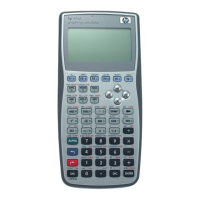6-24 The Development Library
Syntax Example Notes
K<ML77!
Stops the remote control (ON+S).
>LDELY!
Wait for (C[A]/183) ms.
YDOK<<=!
Return how many columns the screen contains in Ca
D<::6M<!
Sets the RTC time from C[W] in ticks.
D<:E=<4!
Set number of lines of disp0 from C[B], refresh display.
D<:L774!
Set offset of display inside disp0 in bytes from C[X]&7FF.
;DOK<<=!
Return how many lines the screen contains. In Ca
5=O=7>4!
Unconfigure the 4KB block containing the top 16-line header.
This will refresh the header on the display.
><::6M<!
Emulates gettime function in ROM, and also updates the 8192Hz timer
accordingly.
Purpose:Get current time: (=NEXTIRQ)-Timer2
Return CS iff time appears corrupt.
Entry: Timer2 Running
Exit: Timer2 Running
CC - A:NEXTIRQ (ticks)
C:Time (ticks)
D:Timer2 (sgn extended ticks)
P:0, HEX
CS - Same as the non-error case but the time system
is corrupt because of one of:
(1) TIMESUM # CRC(NEXTIRQ) -- CheckSum Error
(2) TIMER2 was not running on entry.
(3) Time not in range: [BegofTime, EndofTime)
M64B22b!
Carry=1 on HP48, 0 otherwise.
OL=76>4!
Configure a 4KB block containing the top 16-line header.
C.A = Start address of the block (must be multiple of 4KB).
If already configured, unconfig, refresh and re-config.
S6>B22b!
Carry=1 on HP49, 0 otherwise.
K<D<:LD!
Reset the calculator (including the OS).
This code doesn't return, the calculator restarts at 00000000.
K<7K<D;4!
Force to refresh the header on the display.
B5:L:<D:!
- 003AA: AUTO_USER_TEST
- 003A3: MANU_USER_TEST
- 0039C: MANUFACTURE_TEST
- Other: signed index, OS-specific, see OS_API.doc.
BOO<DDD4!
SD Card functions (depending on P, see HP's vgeraccess for more details.
2LK::B>b!
Return port number depending on tag name.
Entry: D1: name (size+chars)
Exit: A[A]: port number (0-3)
D1: after name
Carry: clear if ok, set if wrong name
4.3 ARM mode
4.3.1 ARM architecture
For all user intents and purposes the ARM CPU has sixteen 32 bit registers noted R0 to R15 (R15 is also the
program counter, R14 is the link register (ie: a BL (GOSUB) instruction copies the return address in R14 before
jumping, a Return From Subroutine is performed by doing MOV PC, LR), and R13 is the Stack pointer).
Each instruction can be conditionally executed depending on the value of 5 flags.
Each instruction can be told to modify or not modify these 5 flags (add the S suffix to the instruction).
Please read the ARM ARM (ARM Architecture and Reference Manual) for more information.
Please look at the ARMSAT Saturn instruction and the ARM mode documentation to see the instruction set and the
rules of calling ARM code from Saturn code.

